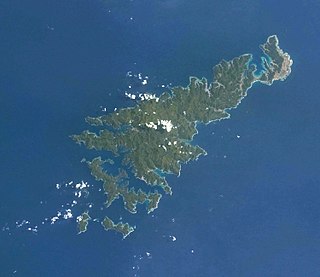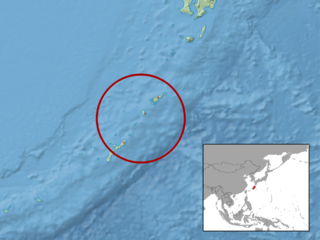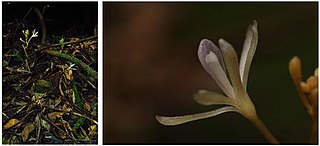
Amami Ōshima, also known as Amami, is the largest island in the Amami archipelago between Kyūshū and Okinawa. It is one of the Satsunan Islands.

Tokunoshima, also known in English as Tokuno Island, is an island in the Amami archipelago of the southern Satsunan Islands of Kagoshima Prefecture, Japan.

Lecanorchis is a genus of orchids belonging to the subfamily Vanilloideae.

The Yanbaru whiskered bat(Myotis yanbarensis) is a species of vesper bat in the genus Myotis.

Gastrodia, commonly known as potato orchids or as 天麻属 , is a genus of terrestrial leafless orchids in the family Orchidaceae, about ninety of which have been described. Orchids in this genus have fleshy, upright stems and small to medium-sized resupinate flowers with narrow sepals and petals. They are native to Asia, Australia, New Zealand, central Africa, and various islands of the Indian and Pacific Oceans.

Didymoplexis, commonly known as crystal orchids or as 双唇兰属 , is a genus of terrestrial leafless orchids in the family Orchidaceae, about twenty species of which have been described. Orchids in this genus have swollen, fleshy rhizomes and thin, pale, upright fleshy flowering stems with resupinate, bell-shaped white or pale yellowish brown flowers. They are native to Africa, Madagascar, Southeast Asia, Australia and various islands of the Pacific.

Yambaru National Park is a national park in Okinawa Prefecture, Japan. Established in 2016, it is located in and around the forested region of Yambaru at the northern end of Okinawa Island. The park comprises a land area of 13,622 ha in the villages of Kunigami, Ōgimi, and Higashi together with 3,670 ha of the surrounding waters. The day of establishment, 15 September, coincides with the anniversary of the 1983 discovery of the endangered endemic Yambaru long-armed scarab beetle .
Gastrodia kuroshimensis is an unusual species of plant that was discovered in April 2016. It is mycoheterotrophic, meaning that it does not engage in photosynthesis like most plants but obtains energy from its host fungi. It is also cleistogamous, meaning that it produces flowers that never open. Since its flowers never open, it is self-fertilizing.

Lecanorchis tabugawaensis is a species of orchid which belongs to the group of mycoheterotrophic plants. Mycoheterotrophs are known for feeding off of the roots of fungal hosts, instead of utilizing photosynthesis. Myco-heterotrophy refers to the harmonious relationship between particular plants and fungi. After a thorough exploration of the plant's shape, size, and structure, it was determined to be closely associated with orchidaceous Lecanorchis amethystea, although inward variations confirmed this unique species.

Amami Guntō National Park is a national park in Kagoshima Prefecture, Japan. Established in 2017, the park comprises a land area of 42,181 ha and a sea area of 33,082 ha. The national park includes areas of these islands: Tokunoshima, Kikai, Amami, Yoron, Okinoerabujima, Uke Island, Kakeromajima and Yoroshima.

Carlos Adolfo Lehnebach is a New Zealand botanist. He is employed as a botany curator at the Museum of New Zealand Te Papa Tongarewa. Lehnebach has a master's degree and a PhD from Massey University.

Gastrodia cooperae, also known as Cooper's black potato orchid, is a species of plant in the family Orchidaceae and is endemic to New Zealand. The specific epithet cooperae refers to Dorothy A. Cooper, founder of the New Zealand Native Orchid Group.
Gastrodia urceolata, commonly known as white potato orchid, is a leafless terrestrial mycotrophic orchid in the family Orchidaceae. It has a pale brown, fleshy flowering stem and up to fifty five upright, white to pale brown flowers. It is only known from a single population near Atherton in Queensland.
Amyema lisae, is a species of flowering plant, an epiphytic hemiparasitic plant of the family Loranthaceae first discovered in 2017 at Balinsasayao - Twin Lakes Natural Park, in the island of Negros, Philippines. Amyema lisae differs due with verticillate arrangements of leaves and simple umbels in the inflorescences. Its leaves are also relatively smaller leaves. The 5-merous flowers are tomentose and yellow, making it the only mistletoe species in the Philippines to have a yellow flower.
Gastrodia gunatillekeorum is a new species of potato orchid discovered in Sinharaja rainforest and described in 2020. Each with less 100 mature individuals, only three small populations have been discovered as yet. This plant was named after Nimal Gunatilleke and Savithri Gunatilleke.
Gastrodia zeylanica is a species of potato orchids which is endemic to Sri Lanka. It was added to the 2007 Red list of Threatened Fauna and Flora of Sri Lanka as 'critically endangered', on the basis of it having only been collected from a few localities.
Gastrodia spatulata is a species of Gastrodia native to Indonesia and Malaysia. It is known from Borneo and Java.
The Philippine Taxonomic Initiative (PTI) is a private Philippine research institute and non-profit organization founded in 2018, located in the Philippines.

Amami-Ōshima Island, Tokunoshima Island, northern part of Okinawa Island, and Iriomote Island (奄美大島、徳之島、沖縄島北部及び西表島) is a serial UNESCO World Heritage Site consisting of five component parts on four Japanese islands in the Ryukyu Chain of the Nansei Islands. The site was selected in terms of biodiversity for having a diverse ecosystem of plant and animal species that are unique to the region.
Asimitellaria amamiana is a species of flowering plant in the family Saxifragaceae that is endemic to Amami Ōshima in the Amami Islands of Kagoshima Prefecture, Japan.











